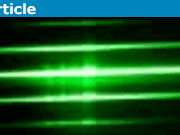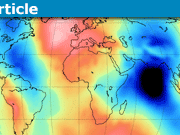“Violating” Einstein’s Photoelectric Effect Model
One of the most spectacular theoretical descriptions that Einstein had ever produced is the corpuscular nature of light that he used in his 1905 photoelectric effect paper. In fact, there have been arguments put forth that of all of his 1905 papers, the one proposing this model for light is what is truly most revolutionary, even more than his special relativity theory.
In case you need a refresher, the photoelectric effect experiment is where you shine light onto a surface of a material (typically a metal). If the light has sufficient “energy”, then photoelectrons are emitted. What was puzzling before the 1900s was that light, as understood as a wave via the Maxwell Equations, seemed to not be behaving the way it should within this photoelectric effect experiment. The energy of the light wave was tied to its intensity – the larger the intensity, the larger the energy.
Yet, in the photoelectric effect experiment, there were two puzzling observations:
1. As one increases the intensity, the energy distribution of the emitted photoelectrons does not change. Electrons are not emitted with more energy. Rather, increasing the intensity simply increases the number of electrons being emitted. The energy distribution remains the same as before.
2. If the frequency of the light is below some value, then no matter how intense the light is, no electrons is emitted.
Einstein took those two puzzling observations and reformulated the light description, tying the frequency, not the intensity, to the energy of light. Not only that, he proposed that light’s energy comes in discrete quantum (photon). He then proposed a simple description of the photoelectric effect experiment:
KE = hf – F
where KE is the kinetic energy of the emitted photoelectrons, hf is the energy of each photon (f is the frequency of light and h is the Planck constant), while F is what is known as the work function of the material. When the photoelectric effect is defined this way, then a natural explanation for both #1 and #2 is obtained. Since light’s energy only depends on the frequency, increasing the intensity does nothing to the energy of each photon. The intensity only affects the rate of photons being emitted, thus that explains why we obtain more photoelectrons, but with the same energy distribution. And if the frequency of light is less than the work function F, then no matter how high the intensity is, it is still less than F and therefore unable to produce any photoelectrons.
This photoelectric effect description was soon experimentally verified by Millikan (who initially was very skeptical of Einstein’s description, but later on admitted that all of the experiments seemed to point to its validity). Since then, Einstein’s formulation of what light has certainly been verified and accepted many times over, and is the only description of light being used in much-advanced applications such as photoemission spectroscopy.
Still, does this mean that we do not have any evidence that this description can be “violated”? I’m putting “violated” in quotes because, as I’ll explain later on, it turns out that, as is the case in many areas of physics, the photoelectric effect description of Einstein is only the simplest, most naive description of a “single-photon” photoemission. What this implies is that we have several situations where Einstein’s photoelectric effect equation can be “violated”.
There are two different types of experiments where this can be done.
A. The Schottky effect type experiment.
This type of experiment was done[1] even way back in the 20th century, even by giants in physics such Ernest Lawrence[2]. This is where the same photoelectric effect experiment was done but in a rather high external accelerating electric field. This field is applied usually perpendicular to the metal’s surface in the direction that will accelerate the emitted electrons away from the metal’s surface. What is observed here is that one can in fact observe the emission of electrons even when the energy of the photons is LESS than the work function (violation of #2 above). What is going on here is that the applied electric field acts in such a way that it lowers the effective work function of the metal. The photons with lower energy can start to emit electrons even below the metal’s bulk work function.
B. Multiphoton photoemission.
This discovery occurs especially after lasers were invented, and high-intensity monochromatic light sources become easily available. What is observed in these experiments is that, even without applying any high fields to the metal (i.e. no lowering of the effective work function), one can still get photoelectrons even using photons with energy lower than the work function, especially when one increases the intensity of the light source by a lot. This again violates #2. A very simple explanation for this is that, with highly intense light sources such as those coming from a laser, one can induce a multiphoton photoemission process.[3,4] This is where the first photon excites an electron in the metal’s conduction band to an intermediate state. Normally, its lifetime in the femtosecond range would cause it to decay back down. But with a highly intense light source, the probability of another photon being absorbed by that excited electron before it decays becomes significant. Thus, if you have a light source with photon energy just slightly more than half of the work function, there is a non-negligible probability that you can now have an emission of electrons due to the absorption of 2 photons. One can easily imagine this being done for 3, 4, etc.. photons. Of course, the probability of emission with a higher number of photons is significantly lower.
So here, I’ve just described two different ways of violating Einstein’s photoelectric effect description[5]. So does this mean that we should try to get the Nobel committee to revoke Einstein’s prize? Does this mean that the photoelectric effect description is no longer valid?
NO!
The most significant consequence of Einstein’s photoelectric effect description – the photon – is STILL valid and very much alive. In fact, the multiphoton experiments could not be easily explained without using the concept of photons. What we know now is that Einstein’s description is valid only for the simplest case – an emission of the electron using single photons only, i.e. single-photon photoemission and under a revised definition of the work function being the EFFECTIVE work function, rather than the original bulk work function. As with other aspects of physics, we make progress in the study of an area, and now we know more of what we didn’t know then. Einstein’s work opened the pathways to viewing light in a different way. Without such insight, most of what we know now in this area would not have been possible. Just as Newtonian mechanics became more of an approximation (albeit a valid one at our normal scales), Einstein’s equation also became more of a special case valid for the simplest situation.
Zz.
[1] E. Guth and C.J. Mullin, Phys. Rev. v.59, p.867 (1941).
[2] E.O. Lawrence and L.b. Linford, Phys. Rev. v.36, p.482 (1930).
[3] K. Giesen et al., Phys. Rev. Lett. v.55, p.300 (1985).
[4] W.S. Fann et al., Phys. Rev. B v.44, p.10980 (1991).
[5] There is actually another way, via heating the metal. See, for example, R.H. Fowler, Phys. Rev. v.38, p.45 (1931).
PhD Physics
Accelerator physics, photocathodes, field-enhancement. tunneling spectroscopy, superconductivity







There are some ideas how infrared light can get converted to visible light (with sufficient energy per photon to be used by the cell) by combining the energy of at least two photons. The efficiency gain won't be large, but maybe better than nothing.
Mirrors are independent of all those ideas.
I was wondering if these violations of Einstein's rule could be used to make photo voltaic cells more efficient? Keep in mind that with the concentrated solar principal (more info here http://www.technologyreview.com/news/540856/doe-attempts-to-jump-start-concentrated-solar/ ) acres of mirrors can concentrate light onto a few solar cells. Thank you for your time!
Nice article Zz!
Thank you ZapperZ for a thoughtful insight article! The simplest cases such the one addressed by Einstein are typically the most beautiful and elegant ones. The extensions that comes later such as the electric field effect, heat effect or mutli-photon processes are typically the most labor-intensive less beautiful but technologically important cases.